Whenever we talk about deserts, the most common scene that comes to mind is sand, cactus, and ostrich. We all have common thoughts, right? So, have you ever thought about any other birds that live in deserts? So here we are going to look at ten bird species found in deserts. But the most interesting thing we are going to do is learn about them according to their body length. So here we go.
Top 10 Largest Birds That Live in Deserts
10. Gyrfalcon
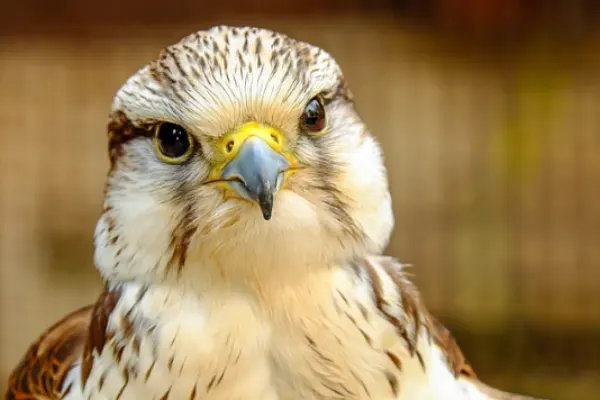
| Scientific name | Falco rusticolus |
| Size (length) | 48-61 cm |
| Life Span | Up to 20 years |
| Diet | Sage-grouse, jaegers, gulls, terns, fulmars, auks, pheasants, hawks, owls, ravens, and songbirds |
The last place in our list of birds that live in deserts is gyrfalcon, the largest falcon species, breeds on Arctic coasts, tundra, northern North America, and the Eurosiberian region. Its plumage varies, with colors ranging from all-white to dark brown.
Males are 48 to 61 centimeters long, weigh 805 to 1,350 grams, and have a wingspan of 110 to 130 cm. Females are bulkier and larger, with wingspans ranging from 124 to 160 cm.
The gyrfalcon is larger, broader-winged, and longer-tailed than the peregrine falcon, which it competes with and occasionally hunts.
9. Red-tailed Hawk
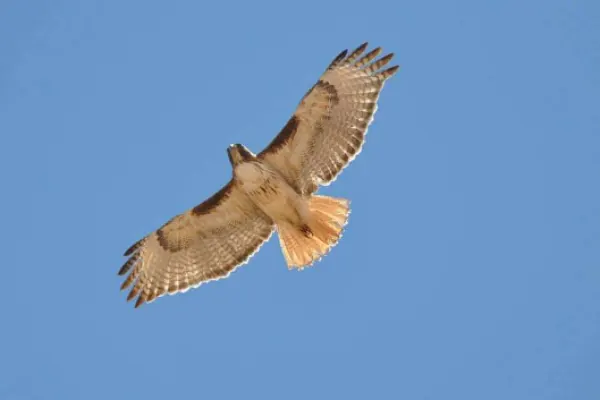
| Scientific name | Buteo jamaicensis |
| Size (length) | 45–65 cm |
| Life span | 10-12 years |
| Diet | Small mammals |
The red-tailed hawk is a bird of prey found in North America, primarily in Alaska, northern Canada, Panama, and the West Indies. It is part of the “chickenhawk” species and can adapt to various habitats and altitudes.
The western North American population, B. j. calurus, has three main color morphs: light, dark, and intermediate or rufous.
Adult red-tail hawks have a dark-brown nape and upper head, a slightly darker back, and a light buff-orange tail.
8. Roadrunner

| Scientific name | Geococcyx californianus |
| Size (length) | 51-66 cm |
| Life span | 7-8 years |
| Diet | Plants and small animals |
Roadrunners, also known as chaparral birds or chaparral cocks, are two species of fast-running ground cuckoos found in the southwestern and south-central United States, Mexico, and Central America.
They are large, slender, black-brown, and white-streaked ground birds with distinctive head crests, long legs, strong feet, and an oversized dark bill.
They can run at speeds of up to 32 km/h (20 mph) and generally prefer sprinting to flying. On the ground, some have been clocked at 32 km/h (20 mph).
The lesser roadrunner is slightly smaller and has a smaller bill. Both lesser and greater roadrunners leave distinct “X” track marks, appearing as if they are traveling in both directions.
7. Common Raven
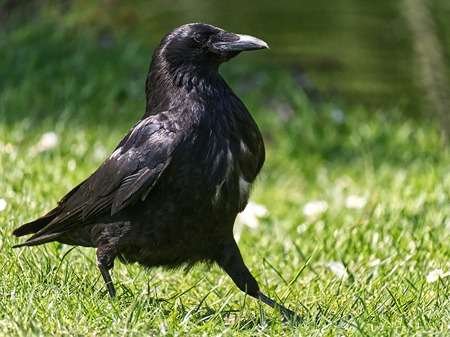
| Scientific name | Corvus corax |
| Size (length) | 54-71 cm |
| Life span | 10-15 years |
| Diet | Small mammals to nesting birds, eggs, and berries |
The common raven is a large, all-black passerine bird found in the Northern Hemisphere, one of the two largest corvids and possibly the heaviest. A mature raven ranges between 54 and 71 cm and has a wingspan of 116 and 153 cm.
Its bill is large and slightly curved, with a culmen length of 5.7 to 8.5 cm. Common ravens differ from crows by having a larger and heavier black beak, shaggy feathers, and a wedge-shaped tail.
They can mimic sounds from their environment and produce non-vocal sounds, such as wing whistles and bill snapping.
6. Turkey vulture
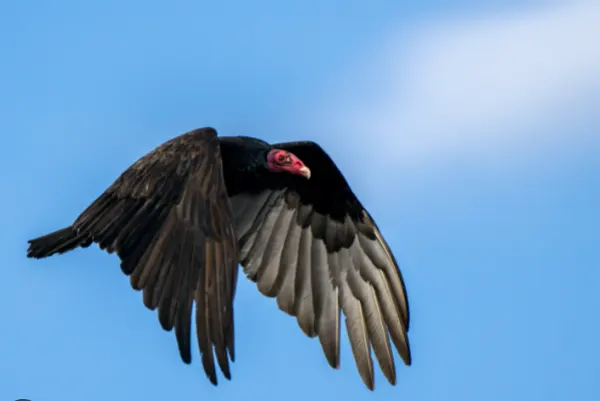
| Scientific name | Cathartes aura |
| Size (length) | 62–81 cm |
| Life span | 16-30 years |
| Diet | Meat |
The turkey vulture is a widespread New World vulture found in various open and semi-open areas such as subtropical forests, shrublands, pastures, and deserts.
It is one of three species in the genus Cathartes of the family Cathartidae and has a wingspan of 160–183 cm and a length of 62–81 cm.
The adult bird has a small, red head with few to no feathers and a short, hooked, ivory-colored beak. It displays minimal sexual dimorphism and has brownish-black body feathers and silvery-gray flight feathers.
The turkey vulture has a short, hooked, ivory-colored beak and a gray head with a black beak tip. Captive longevity is not well known, but there are captive birds over 48 years old, such as Lord Richard and Nero. The oldest wild-caught banded bird was 16 years old.
5. Eurasian bittern

| Scientific name | Botaurus stellaris |
| Size | 69-81 cm |
| Life span | 10-12 years |
| Diet | Fish, small mammals, amphibians and invertebrates |
The Eurasian bittern, also known as the great bittern, is a secretive bird in the bittern subfamily of the heron family Ardeidae. It is the largest of the bitterns, with males being larger than females.
The bird has a bright, pale, buffy-brown plumage covered with dark streaks and bars. The breast and belly are yellowish-buff, with broad stripes of brown at the side and narrow stripes in the center.
The wings are pale, rusty-brown, irregularly barred, streaked, and mottled with black. The powerful bill is greenish-yellow with a darker tip to the upper mandible.
The eye has a yellow iris and is surrounded by a ring of greenish or blue bare skin.
4. Golden Eagles

| Scientific name | Aquila chrysaetos |
| Size | 70-84 cm |
| Life span | Up to 30 years |
| Diet | Small mammals |
The golden eagle is a bird of prey found in the Northern Hemisphere, belonging to the Accipitridae family. Do you know these dark brown birds have lighter golden-brown plumage on their napes and use their agility, speed, and powerful feet to hunt various prey?
Also, adults have paler golden-brown plumage on the back of the crown and nape, while juveniles are darker and have white patches on their remiges.
Furthermore, you can find this species of birds in tundra, grasslands, intermittent forested habitats, woodland brushlands, arid deserts, and canyonlands.
3. Bearded vulture

| Scientific name | Gypaetus barbatus |
| Size | 94–125 cm |
| Life span | 21-45 years |
| Diet | Primarily of bone |
The bearded vulture, also known as the lammergeier and ossifrage, is a large bird of prey and the only member of the genus Gypaetus.
It is 94–125 cm long, weighs 4.5-7.8 kg, and is compared to a falcon in size. The bird has a long, narrow wing chord and a wedge-shaped tail, making it unmistakable from other vultures or other birds in flight.
The adult bearded vulture is mostly dark gray, rusty, and whitish in color, with a black band across the eyes and pores and bristles under the chin.
The juvenile bird is dark black-brown over most of the body and takes five years to reach full maturity. The bearded vulture is silent except for shrill whistles in breeding displays and a falcon-like cheek-ache call around the nest.
2. Osprey

| Scientific name | Pandion haliaetus |
| Size | 127–180 cm |
| Life span | 7-10 years |
| Diet | Fish |
The osprey, a large raptor bird of prey, is brown on the upperparts and grayish on the head and underparts. It weighs 0.9–2.1 kg and measures 50–66 cm in length with a wingspan of 127–180 cm.
The osprey’s distinctive appearance includes a deep, glossy brown upperpart, a white breast, and pure white underparts.
The head has a dark mask, and the irises are golden to brown. The bill is black with a blue cere, and the feet are white with black talons. In flight, the osprey has arched wings and drooping “hands,” giving it a gull-like appearance.
1. Common Ostrich
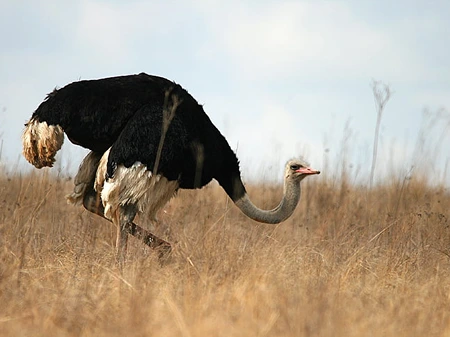
| Scientific name | Struthio camelus |
| Size | Approx. 275 cm |
| Life span | 30-40 years |
| Diet | Plants, insects, snakes, lizards and rodents |
The first place in the list of birds that live in deserts goes to the common ostrich, a flightless bird native to Africa, that stands 21 to 275 cm tall and weighs 100 to 130 kg.
It is the largest living bird and the heaviest, with black feathers in adult males and grayish-brown and white in females. The tarsus of the common ostrich is the largest of any living bird, measuring 39 to 53 cm in length.
The bird is didactyl, having two toes on each foot, and can run at over 70 km/h. Their feathers are soft and fluffy, and they can tolerate a wide range of temperatures.
Conclusion:
So yes, these are ten birds that live in deserts. We hope that you find it inspiring to learn about it. If you are interested in learning about the animal kingdom and want to know more about it, Follow our journey to the animal kingdom on HowItSee.
Also Read:

As a content writer, I like to write about different niches. I have a curiosity about nature and animals. And like to learn about them. Through my writing, I like to share my experience and knowledge with you. I hope you are enjoying it too.

